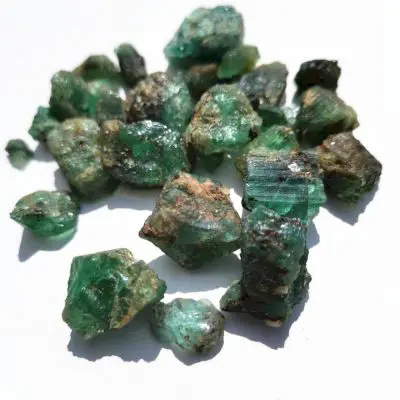Afghanistan's emerald mines are located in the heart of the Panjshir Valley and the Hindu Kush Mountains, 100 km northeast of Kabul, at an altitude of 3,000 to 4,000 meters

Emeralds are relatively rare Gemstones compared to other minerals. They are a variety of the mineral beryl and owe their distinct green color to trace amounts of chromium and sometimes vanadium. The combination of these elements is not commonly found in nature, making emeralds less abundant than other gemstones. The vibrant green color of emeralds is highly prized. It is often described as a deep, intense green that can range from bluish-green to yellowish-green. The presence of chromium and vanadium gives emeralds their characteristic green hue, and the color is considered one of the most important factors in determining the value of an emerald.
Unlike some other gemstones, emeralds often contain natural inclusions and imperfections. These inclusions, known as jardin (French for "garden"), are often visible to the naked eye and can resemble moss or vegetation trapped within the stone. While flawless emeralds do exist, they are exceptionally rare and command higher prices. Inclusions are considered part of the character of an Emerald and can help authenticate its natural origin. The most famous and historically significant emerald deposits are found in Colombia, particularly in the Muzo, Coscuez, and Chivor mines. Colombian emeralds are highly regarded for their deep green color and exceptional clarity. Other significant sources of emeralds include Zambia, Brazil, Afghanistan, and Zimbabwe. Each source can produce emeralds with unique characteristics, such as variations in color, clarity, and even slight differences in the Chemical composition.
Numerous legendary emeralds have gained fame throughout history. One notable example is the "Mogul Emerald," a 217.80-carat emerald engraved with Islamic prayers, dating back to the Mughal Empire. The "Chalk Emerald" is a 37.82-carat emerald with a rare bluish-green color, once owned by socialite and Jewelry collector Bunny Mellon. The "Duke of Devonshire Emerald" is a 1,383.95-carat rough emerald with a fascinating history and is currently housed in the Natural History Museum in London.
Emerald is the second most precious Stone after Diamond in Afghanistan and some parts of the world. Afghanistan emerald is unique in the world in terms of its transparency. It is the fourth largest exporter of emeralds after countries such as Brazil, Colombia and Zambia. What makes Afghanistan emerald unusual is its excellent transparency.
The value of an emerald is determined by several factors, including color, clarity, size, and origin. Fine-quality emeralds with intense, evenly distributed green color, minimal inclusions, and larger carat weights command the highest prices. Colombian emeralds are generally regarded as the finest, while emeralds from other sources may have variations in color and value. The market for emeralds can be highly competitive, and exceptional Stones with exceptional characteristics can reach astronomical prices at auctions and private sales.
Most emeralds, even quality emeralds, have superficial cracks, but Afghan emeralds are usually extraordinarily clean and small in size but of very high quality. Afghanistan's emerald mines are located in the heart of the Panjshir Valley and the Hindu Kush Mountains, 100 km northeast of Kabul, at an altitude of 3,000 to 4,000 meters. These mines can only be reached on foot. In Panjshir valley, 172 small and large emerald mines have been discovered so far. The Afghan emerald mine was first discovered in 1970 by a Russian geologist.
While emeralds are not as hard as some other gemstones like diamonds, they still possess good durability for everyday wear. They rank 7.5 to 8 on the Mohs scale of mineral hardness, which means they are relatively resistant to scratches and can withstand regular wear with proper care. Emerald means green and its name is derived from the Greek word "Smaragdos" which some say is derived from Persian. In the past, all green crystals were called emeralds. The first reference to it in Western literature is from Aristotle.
Emeralds are sometimes treated to enhance their appearance and clarity. One common treatment is the use of oils or resins to fill surface-reaching fractures and improve the stone's clarity. This treatment is widely accepted in the industry, as long as it is disclosed to the buyer. However, it is important to note that heavily treated or synthetic emeralds may be of lower value compared to natural, untreated stones. Larger emeralds are relatively rare compared to smaller ones, and their value increases exponentially with size. This is because larger emeralds with good color and clarity are highly sought after by collectors and connoisseurs. Fine-quality emeralds over one carat in weight can command significantly higher prices per carat compared to smaller stones.
Emeralds are known for their exceptional beauty and aesthetic appeal. Their rich color and lustrous appearance make them highly desirable gemstones. They are often cut into various shapes, such as emerald cuts, to maximize their beauty and showcase their color. Emeralds have a long history and have been valued by different cultures throughout time. They have been associated with royalty, wealth, and power. In ancient civilizations like Egypt and Rome, emeralds were considered symbols of fertility, rebirth, and immortality. They have also been associated with love and are often used in engagement rings.





